Step-by-step instructions for planting horseradish in the fall for beginner gardeners
Horseradish - an amazingly tenacious perennial plant, which many gardeners consider almost a weed. However, horseradish turns into a weed only with improper care.
Even a beginner can cope with planting this culture on his site. It is for novice gardeners that we suggest that you familiarize yourself with the features of planting horseradish in the fall, the planting scheme and detailed instructions.
The article will tell you how and when to plant, how to properly care for the plant after planting.
The content of the article
Is it possible to plant horseradish in the fall before winter
The best time to collect horseradish is October, then the ideal time for grafting and planting it comes.
Planting before winter provides the plant with characteristic properties: horseradish will grow with increased pungency and sharpness, the rhizome (its main valuable part) will gain the required mass, will be strong and large.
Advantages and disadvantages of autumn planting
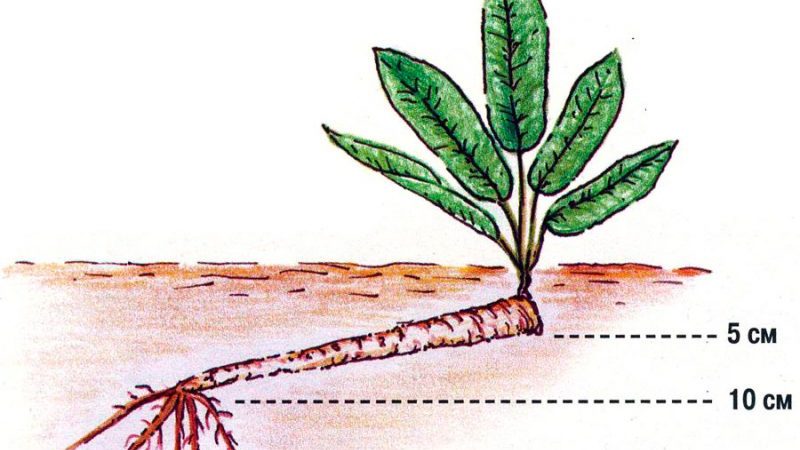
The earliest harvest is obtained with this type of planting. This is especially important for regions with late spring and short summer. In this case, the horseradish crop is ready to be harvested not at the end of autumn, but at the height of the canning season. It is then that it is especially needed - it is used for home preservation everywhere, without it it will not be possible to make adjika, horseradish, properly pickle cucumbers and tomatoes.
The culture does not like return frosts. But plants planted in autumn are not afraid of spring frost. Winter landing is good hardening.
There are practically no drawbacks to winter planting, and another plus - in the spring you get extra time, which is so precious, for other urgent work in the country: in the garden or in the garden.
Landing dates
It used to be determined when to plant horseradish, according to folk signs. They planted it before the onset of stable cold weather, when the leaves begin to actively fall off and frosts occur at night.
Optimal terms, depending on the region of cultivation
According to the many years of experience of gardeners in different regions, a good time for planting horseradish in central Russia and the Moscow region is mid-October. In the northern regions, planting is carried out earlier, in the middle or at the end of September.
Lunar landing
Lunar phases have an impact on plants, because many people compare the timing of planting horseradish with the lunar sowing calendar. An incorrectly chosen day can negatively affect the future harvest. It is recommended to plant on the growing moon. It is at this time that the plants are most viable, the cuttings planted in the third quarter of the lunar month root well.
In the second half of October 2019, the most favorable dates for landing are October 29-31. These are 2-5 lunar days with a waxing moon.
In October 2020, favorable for planting horseradish: October 17-23, 26-27 and 31 October.
How to choose a landing site
Many gardeners consider horseradish to be an aggressive and extremely unpretentious plant.
However, the culture is very sensitive to planting and growing conditions:
- The soil should be acidic enough, it is better to acidify overly alkaline soils.
- Horseradish loves moisture, but does not tolerate waterlogging. The soil should be moderately moist, but not too damp.
- Suitable soil - fertile black earth or sandy loam and loamy, with the addition of peat and organic fertilizers.On poor, heavy soils, it does not gain root mass and the necessary concentration of essential oils, on which its pungent taste depends.
- The mechanical composition of the soil is important: it prefers light soils, on dense soils it grows tough and rough.
This light-loving culture grows well in partial shade, does not like thick shade and direct sunlight.
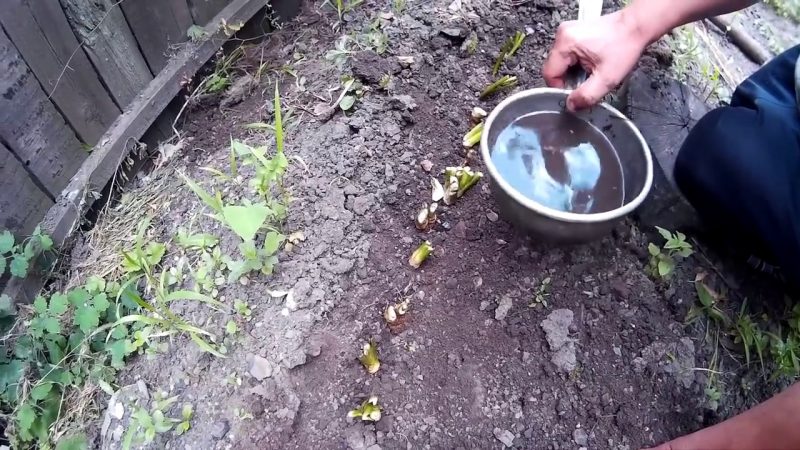
What to plant next to, is it necessary to follow the rules of the neighborhood
In order not to damage the roots of fruit bushes and trees in the future, plan to plant horseradish away from them. Plant it in areas where potatoes and any legumes have grown.
Do not plant horseradish and strawberries next to it, otherwise the berry yield will be low, as they will compete for lighting and nutrients.
Training
High-quality horseradish grows only from healthy planting material on properly prepared soil. Before planting, do some preliminary preparation.
Planting material
Horseradish propagates by dividing the root into root cuttings. To get cuttings:
- Dig up the horseradish bush and separate the lateral roots 20-30 cm long and about 1 cm in diameter.
- Make the bottom cut at an oblique angle, cut the top horizontally. This will mark the top and not plant the stem upside down.
- Peel off the buds on the middle of the cutting using a coarse glove or burlap. Leave some buds on the top and bottom cut where leaves and roots will form.
The buds are removed if the planting of horseradish is carried out to obtain large, even rhizomes, so that they do not give a lot of extra small roots. If the goal is horseradish reproduction, then all the kidneys are left.
Reference. Store the prepared cuttings in the sand in a cool place until planting.
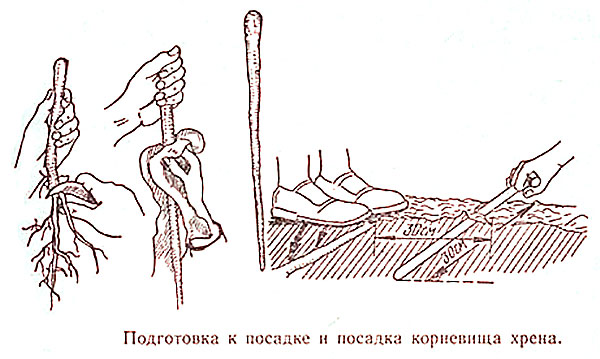
Soil
When preparing the soil for planting horseradish, dig the garden bed to a depth of 40 cm. Apply mineral fertilizers, compost or rotted manure.
How to properly plant horseradish in the autumn
So that horseradish gives a high-quality crop of roots and leaves, but does not creep over the site, they dig it up in the fall, and in the spring they plant it again with cuttings.
Step-by-step instruction
Follow the step by step instructions:
- Prepare holes, the depth of which exceeds the height of the cuttings by 5-7 cm. Make them with a special planter-hole-forming machine or a wooden peg.
- Plant at a 45 ° slope, deepening the top of the cutting by 4-5 cm.
- When planting a large number of roots, plant in rows according to the scheme 60 x 40 or 30 x 70, where 70 cm is the distance between rows and 30 cm in a row between plants. Planting frequency is 4-6 plants per 1 sq. m.
- Sprinkle them with a layer of earth, if the ground is dry, pour them. If you plant late, in moist soil, no watering is needed.
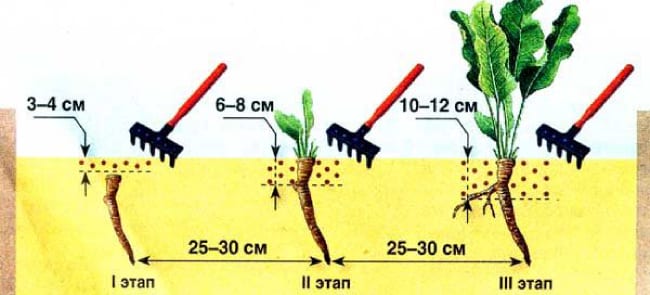
Mistakes to Avoid
Dig up the area carefully after harvest to avoid excessive growth of horseradish. It is not recommended to leave even the smallest roots in the ground, as this plant can spread rapidly.
Important! Horseradish can stay in one place for more than 10 years, but it is recommended to dig it up 1-2 years after planting. Otherwise, horseradish will run wild, put down deep branchy roots and it will be almost impossible to remove it.
To prevent further spreading throughout the site, many gardeners plant cuttings in specially prepared containers: deep boxes, buckets and barrels that restrict the plant's root system. This method allows you to get high-quality rhizomes and not clog the area.
It is interesting:
When and how to plant honeysuckle in autumn and what mistakes to avoid during planting.
How and how to properly feed grapes in the fall.
How to properly prune an apricot in the fall and why you need it.
Planting horseradish in barrels
A popular method of limiting the spread of plants in the garden is to plant in a barrel or other suitable container. Bury it, leaving 15-20 cm high sides above the ground. Or simply place the barrel (without burying) in a remote corner of the garden.Add a mixture of compost and soil there and plant 5-6 cuttings. Dig up a barrel in fall or simply turn it over to its side - the roots will be easy to remove without the slightest damage.
Care after landing
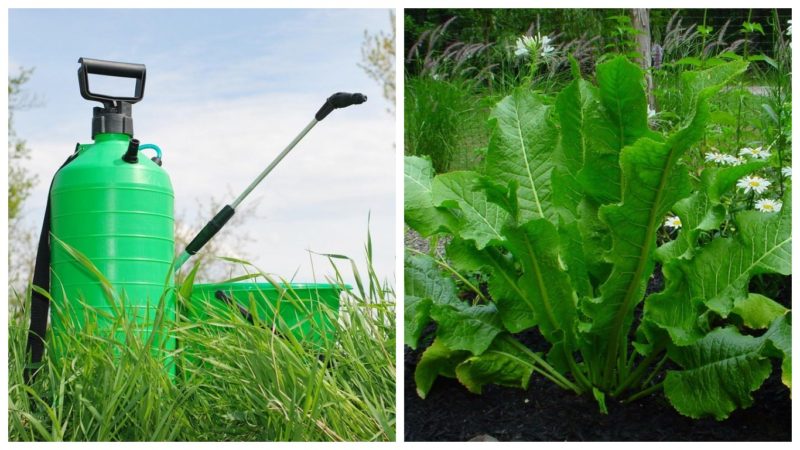
Cuttings planted in autumn do not need shelter for the winter, they can withstand temperatures down to -45 ° C.
In the spring, regularly loosen and water the beds, remove the peduncles (so that they do not take away the strength from the leaves and rhizomes). Adult plants hardly need additional care.
Conclusion
Set aside some time in the fall to plant horseradish in your area. Choose the right place for planting, prepare the soil and planting material in advance. Follow all the recommendations, carefully follow the advice of experienced gardeners, and then the horseradish, planted before winter, will grow large, tart and spicy. Have a nice harvest!